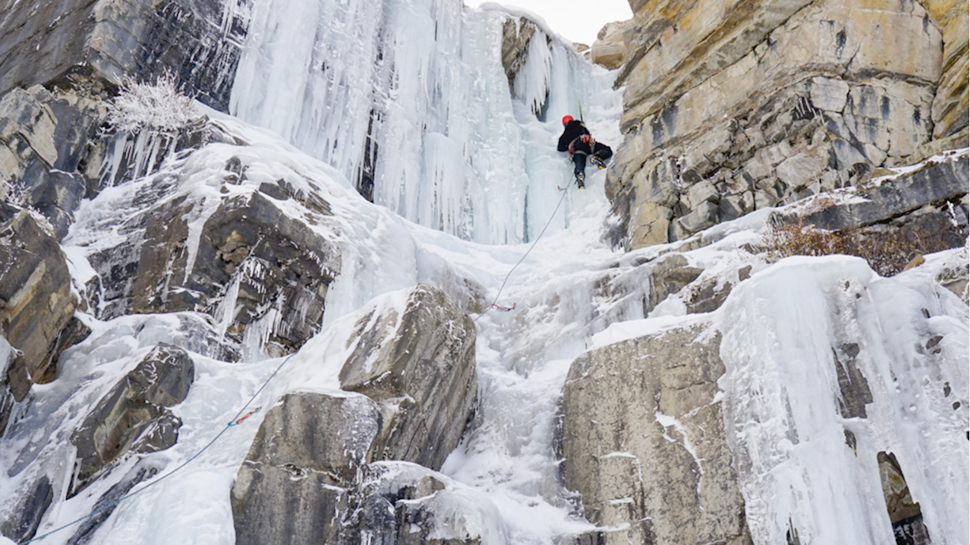Ice Climbing in Southern Idaho
There is a sport flying under the radar of southern Idaho; one where participants willingly head out into freezing temperatures, lugging gear like ropes, crampons, and ice axes before ascending frozen pieces of ice, all for the thrill of what many might consider “type 2” fun. These are ice climbers.

While the sport of rock climbing has seen a major uptick due to the increase in climbing gyms, ice climbing remains on the fringe and for good reason: the conditions are harsh, the ice can be difficult to find, and the sport can be quite dangerous.
The difficulty of finding good ice to climb in southern Idaho means that the best locations aren’t revealed to those outside the community (and maybe not even them). But despite its underground leanings, there is a core group making up the ice climbers of southern Idaho.
The Basics
Most people have a general understanding of rock climbing and ice climbing uses many of the same techniques and terms. The biggest difference, of course, is that ice climbers are climbing on a constantly-changing, malleable surface of ice instead of rock. There are two types of terrain in ice climbing: alpine ice which exists in a mountain environment and usually requires an approach and water ice, which is usually found on a cliff or outcropping under a water flow. While alpine ice is frozen precipitation, water ice is a frozen flow of water like a waterfall or drainage.
No matter the terrain, the ice varies in consistency (soft, hard, brittle, tough) and can be influenced by weather change.
The grading system to rate the difficulty of routes is different than in rock climbing. The biggest difference is that a route’s difficulty can change with weather or even after the first climb; since ice doesn’t remain unchanged like rock, there’s no long-term rating. The system starts at W12 which means that it is low-angled and can generally be climbed with one ice axe, and advances through W17, which requires expert skill. A W17 is extremely rare because of the difficulty; it is basically an overhang of ice with no rests.
The moving of ice makes using specialized gear and equipment crucial; it’s a dangerous sport. Ice axes, crampons, helmets, ropes, and ice screws are critical to any climb.
Where to Climb
With the constantly-changing environment of ice climbing, one can see why knowing the spots that have the most predictably good ice is so secretive.
“If you find a choice piece of rock, rock is rock. You can tell everybody about it and anybody who makes the effort to find and climb it is great,” says Kevin Hansen, a
40-year-old, high-school teacher and ice climber since 2002. “That rock will be there waiting for whoever’s next. In ice climbing, there’s a weird secrecy that happens because if everybody knows about these sweet ‘fishing holes’ everyone’ll fish your secret spot and all the fish are gone.”
It’s no secret that the epicenter of southern Idaho ice climbing is the Snake River Canyon in Twin Falls. It provides easy access to a number of consistent ice climbs of varying degrees of difficulty. The climbs here originate from water running or dribbling year-round that freezes during the winter.
“On a scale of one-to-ten, Twin Falls is an eight,” Hansen says. “It’s got good quantity and quality.”
Sean Muldoon, one of the younger generation of ice climbers coming up in southern Idaho says of Twin Falls, “It’s very wild west when it comes to ice. The ice is thin and a lot of water runs over it; you have structural collapse. It’s fairly common to see, the rate that the water runs down there melts things out quickly.”
Muldoon, a professional photographer in Twin Falls, is entering his fourth season in the sport.
“In Twin Falls, there’s not much of an ice climbing scene so there’s still a pioneer feel to it,” Muldoon says. “I like the dynamic medium. It’s not like rock climbing where it’s the same route and same beta every time; the ice is different, the routes are different. You watch the ice develop, have to scout it. It’s more of a process.”
Indeed, this pioneer feel comes across when talking to any of the several generations of ice climbers in southern Idaho. Back in 1977, Bob Boyles was the first person to climb the north face of Mt. Borah in winter but he and his crew lost some toes along the way. The hardships of ice climbing are enough to make many ask why anyone would do this sport. Aside from the freezing temps and often long approaches to alpine destinations, there’s the danger of constantly-shifting ice, chunks of ice hitting the climber and his partner as an axe swings into it, and the delightfully-named condition known as the “screaming barfies”, a highly painful sensation when a climber’s hands (and sometimes feet) warm up after a period of extreme cold that makes one want to scream, then barf, and repeat.
But despite this, there’s something that draws ice climbers back again and again.
“What I love about ice climbing is you’re in such an amazing environment in an amazing location and you can really look around and say, ‘Human beings were not designed to be here’,” says Hansen. “It’s so exhilarating to be on the side of a frozen waterfall.”
We want to acknowledge and thank the past, present, and future generations of all Native Nations and Indigenous Peoples whose ancestral lands we travel, explore, and play on. Always practice Leave No Trace ethics on your adventures and follow local regulations. Please explore responsibly!
Do you love the outdoors?
Yep, us too. That's why we send you the best local adventures, stories, and expert advice, right to your inbox.







